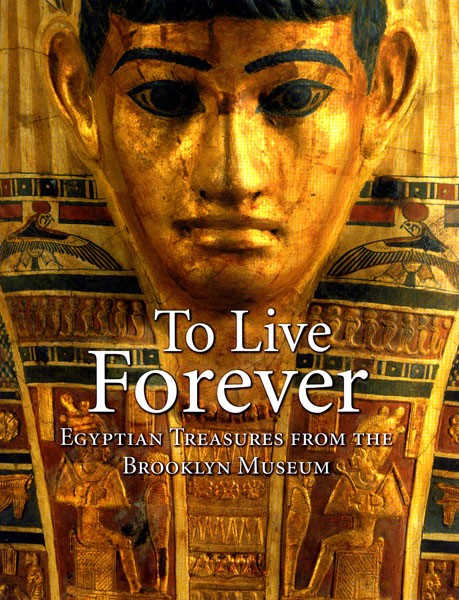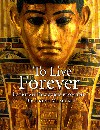To Live Forever: The Brooklyn Museum's Fabulous Egyptian Treasures
A Traveling Exhibition on Funerary Arts and Rituals
By: Charles Giuliano - May 15, 2008
To Live Forever: Egyptian Treasures from the Brooklyn Museum
Curated by Edward Bleiberg with essays by Bleiberg, Kathlyn M. Cooney a forward by Arnold L. Lehman, director of the Brooklyn Museum. 512 pages, illustrated with index and bibliography. Published by the Brooklyn Museum with D Giles Limited, London, 2008.
ISBN 978-1-904832-52-2.
Exhibition itinerary: Indianapolis Museum of Art, Indianapolis, Indiana; John and Mable Ringling Museum of Art, Sarasota, Florida, Columbus Museum of Art, Columbus, Ohio, Chrysler Museum of Art, Norfolk, Virginia, Norton Museum of Art, West Palm Beach, Florida, Frist Center for the Visual Arts, Nashville, Tennessee.
From the prehistoric period of 5,000- 4,400 B.C.E, the Predynastic Period, the 30 Dynasties that ended with the defeat of Antony and Cleopatra in the Battle of Actium, in 30 B.C.E., until the Islamic Conquest of 642 C.E, a defining aspect of Ancient Egyptian art, architecture, and culture was the concern for life after death.
One of the conundrums of art, culture and the humanities, despite a consistency of several millennia, is how little of this remarkable heritage prevailed beyond a fascination for the rituals of the occult. In the teaching of the arts and humanities, even at the university level, Ancient Egypt is relegated to one or two lectures in a survey of art history and not at all in courses in the humanities which generally start with the Greeks but may also include readings from the Old Testament or the Sumerian legend of Gilgamesh. It is possible to graduate from a university with an adequate liberal arts education and yet know little or nothing about the most enduring of all cultures and traditions.
In a sense, Ancient Egypt, despite its remarkable and enduring accomplishments, has suffered neglect and intellectual bashing. The alleged rise of Democracy in 5th Century Athens, however flawed, renders moot the lack of individual freedom in the rigid social and political structure of the Egyptians. While in the matter of religion, I vividly recall being taught by the nuns in primary school that any non Christian peoples, however fascinating, were "barbarians and pagans" and hence to be superficially learned but only as examples of peoples and cultures who did not know Christ and therefore are eternally damned. The nuns did not discuss Rousseau's famous essay on the "Noble Savage."
Even today, in the era of globalization and political correctness, the narrowness of cultural prejudice that elevates the Judeo-Christian heritage and Greco-Roman classicism as academic paradigms continues to ignore with impunity peoples and cultures that are beyond the demographic mandate of students sitting in classrooms. While universities have now added studies of women, African Americans, and, to a lesser extent, Queer Studies, it appears to marginalize other peoples and cultures.
It is remarkable that Native American studies are virtually invisible in the academic mainstream with the exception of states with significant native populations. Similar arguments might be made for Asian studies. While these studies may be neglected because there are too few to generate the requisite "squeaky wheel" what then for the peoples of Ancient Egypt for whom there are no living advocates? When I discussed with my dean, a professor of history, the importance of adding the "niche" of Native studies in the core of the arts and humanities, the response was that "there are many niches." In all discussions of the canon it comes down to how best to slice the pie. Every niche that is included means a reduction of the others. It is ironic that the genocide of Native Americans was so devastating that today there are too few survivors to demand a place at the table.
The marginalization of Ancient Egypt is further exacerbated by the fact that the current population is Muslim which has an ambivalence to its pre Islamic heritage. There are radical mullahs in Egypt who would like to bomb the pyramids and rebury the mummies on display in its museums. For these fundamentalists the graven image is anathema and the display of the embalmed corpses of its pharaohs is sacrilege. Under the Taliban, in Afghanistan, ancient Buddhist images carved into the face of mountains were destroyed despite global pleas that they be spared.
There is an interesting argument here. We do not dig up Charlemagne, for example, and put his corpse and the artifacts of his burial on display in a museum. Why them is it ok to disturb the eternal rest of Tutankhamen? Or, to display the embalmed corpse of Ramesses the Great? Of course the Russians have not gotten around to burying the embalmed corpse of Lenin. Surely a similar display of the corpse of Lincoln would be a major tourist attraction. In recent years, Native Americans have been pursing law suits that museums, such as the Smithsonian, give back ancestral remains and sacred artifacts. Many of these corpses, once relegated to cardboard boxes in basements, have now been properly buried and restored to the earth the mother of us all. The repatriated ritual objects are once again being used in their original tribal context.
Even back in primary school, when the nuns briefly mentioned the "pagans," there were so many unanswered questions. Discussing the rise and fall of Ancient Rome it was implied that they got what they deserved when they fell to those other barbarians who were also pagans. The good news is that those Germanic and Celtic barbarians eventually became Christians. Accordingly, they had done the right thing but ridding us of the godless (actually multi theocratic) Classical tradition. Plato, Socrates, and Aristotle may have been ok but, hey, they didn't make it to heaven. Which is precisely the point that Dante made when his travel companion, the Roman poet Virgil, remained behind when Dante moved on after the Inferno. According to the Dante, purgatory and paradise were available only to Christians.
What then to make of this traveling exhibition and the scholarly book that accompanies it? While the Brooklyn Museum houses an outstanding collection this traveling exhibition is less about circulating its greatest treasures and more about putting together a scholarly and educational overview of funerary rituals and objects.
The essays provide a thorough discussion of Egyptian theology and the process of preparing a corpse for the afterlife. It was a time consuming, labor intensive, and costly undertaking. While every effort was expended for royalty and the aristocracy the essays discuss how this varied for the less wealthy and workers. There were also times of political and social instability so the funerary arts varied accordingly. Until the Islamic Conquest brought an end to it mummification and its rituals were remarkably consistent for some 4,000 years
While the Judeo Christian tradition dominates and makes the Ancient Egyptians somewhat moot, at best fascinating pagans, it is important to note that the concept of one god, or monotheism, preceded the historical Moses. It was first formulated by the "heretic" pharaoh Akhenaton who dedicated the remarkable city of Amarna to the rays of the sun Aten. Prior to him there had been a lesser worship of Amun, the sun disc. This philosopher king, or theocrat, disappeared and was likely murdered. The city was destroyed and the priests/ retainers of his son, the boy/ king Tutankhamen abandoned Amarna and returned to Thebes.
The beliefs of Akhenaton were too radical for the Egyptians who clung to their ancient gods and rituals. Even a pharaoh could not prevail in forcing them to abandon their traditions. Of course, it is fascinating to speculate what influence the monotheism of Akhenaton exerted on the Jews who were captive in Egypt during the end of the 18th dynasty and would leave in the 19th dynasty during the time of Rameses II. Might we more widely respect and study the Ancient Egyptians if we acknowledged them as the founders of monotheism? Would their great, enduring and remarkable heritage mean more to us today than a fascinating but mystical curiosity?
If, as non Christians and pagans, they are denied eternal paradise with the risen Christ in heaven, just where are the shades of all those non believers floating around? It is precisely what makes this exhibition and its scholarly texts so fascinating. These ancient people truly believed in life after death. But they got it wrong. Or did they?


